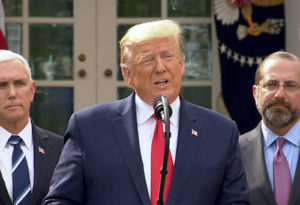
An inaccurate statement that President Trump made during a March 19 news briefing — that the malaria drug hydroxychloroquine had been approved as a COVID-19 treatment — demonstrates how skeptical journalists should remain when covering the unfolding story about treatments and preventative measures.
While there are more than 85 trials for vaccines and treatments underway for COVID-19, scientists don’t expect them to be available to the public soon, despite what some headlines suggest.
For example, a March 16 story in Australia’s Daily Mail sported this headline: “Have they found a cure for the coronavirus?” and detailed the purported effectiveness of certain HIV and malaria drugs in treating some Chinese COVID-19 patients in Australia. The story quoted just one researcher, didn’t say how many patients were tested and lacked links to any underlying scientific evidence, although it did note that a larger study is planned. (The story was updated a day later.)
A Jerusalem Post story on March 17 had Israeli scientists predicting in its headline that “In a few weeks, we will have coronavirus vaccine.” It quoted one government official and the CEO of the company developing the vaccine, which is based on earlier research the company had done to create a vaccine for a poultry coronavirus. Underlying scientific evidence was not linked.
Such coverage, on top of statements and tweets by government officials, may make it seem like a treatment or vaccine can be right around the corner and provide inadequate context about how the scientific process works.
Journalists need to keep explaining these concepts to readers. This ALS Therapy Development Institute explanation of how four stages of clinical trials are necessary before a drug can be considered safe and effective for treatment is a good resource.
“Science is messy,” Laura Helmuth, the Washington Post’s health and science editor, said during a March 19 SciLine media briefing. “It is an iterative process … and showing the readers the process of science is really important” right now.
Helmuth urged journalists to not just quote President Trump without including expert context. Both he and Vice President Pence have on multiple occasions made incorrect statements about the virus, she said.
“This is a big challenge,” Helmuth said. “We are seeing … Trump and Pence say something … and it isn’t true. So, it is really important to not just say, ‘President Trump said this,’ but to say what the evidence is.”
The malaria drug that Trump touted at two separate events that day is being looked at as a potential option but needs to be tested first, according to FDA Commissioner Stephen Hahn. Excitement about the malaria drug grew after a French research group on March 17 published a study involving 36 people that indicated the drug was effective in treating some COVID-19 patients.
The nation’s largest drug companies don’t expect a medical countermeasure to be available for many months, and year to 18 months, or longer, for a vaccine.
At a March 18 media briefing, the drug industry trade group PhRMA highlighted the COVID-19 work of four member companies: Eli Lilly, Sanofi, Takeda Pharmaceutical, GlaxoSmithKline and Pfizer.
“Our industry is working around the clock” to find a medical solution to fighting SARS-CoV-2, the virus that causes COVID-19, said Stephen Ubl, PhRMA’s president and CEO.
Pfizer and Sanofi both are working on vaccines. Pfizer hopes to have its experimental vaccine ready for clinical testing in China and the U.S. by the end of April, said Michael Dolsten, M.D., Ph.D., Pfizer’s chief scientific officer and president of its worldwide research, development and medical unit.
Sanofi, drawing on previous vaccine work to combat the 2003 coronavirus SARS (severe acute respiratory syndrome), is working on a vaccine for the current virus, according to Clement Lewin, Ph.D., the company’s associate vice president. But that work won’t be quick.
GlaxoSmithKline has built a research alliance with vaccine companies to utilize its adjuvant to boost the effectiveness of a COVID-19 vaccine. That means that once a vaccine is found to be safe and effective in preventing development of COVID-19, GSK’s technology could be used to increase the doses available to the public, said Thomas Breuer, M.D., MSc., senior Vice President, chief medical officer at GSK Vaccines.
None of the companies expect a vaccine to be available to the public in 2020.
Sanofi, Takeda Pharmaceutical and Eli Lilly are developing novel treatments for COVID-19 that also are likely to have many months in development.
Sanofi has partnered with Regeneron Pharmaceuticals to conduct experimental trials, using the anti-inflammatory drug Kevzara, on patients already sick with COVID-19 in 16 sites, including New York.
Kevzara, which utilizes antibodies, is approved to treat adults with rheumatoid arthritis, an autoimmune disease. Kevzara has shown promise in reducing an overactive and dangerous immune response to SARS-CoV-19 that’s known as a cytokine storm. (Antibodies are proteins the body produces to fight threatening pathogens.)
“It is an example of how companies can work together to deal with this unprecedented public health emergency,” Sanofi’s Lewin said.
Eli Lilly is working on an antibody therapy in collaboration with AbCella, a Canadian company. In a similar approach, Lilly will use antibodies, harvested from patients who have recovered from COVID-19, to develop a treatment to fight the disease, said Daniel Skovronsky, M.D., Ph.D., Eli Lilly’s chief scientific officer and president of Lilly Research Laboratories.
Takeda also is looking to recovered COVID-19 patients for a potential treatment. The Osaka, Japan-based company is working with the U.S., Japan and Singapore governments to collect blood from recovered patients.
Plasma from the donor’s blood will be used to develop hyperimmune globulins (a type of protein) that has been used with success to treat patients with severe respiratory illness. Julie Kim, president of Takeda Plasma-Derived Therapies, hopes the company will have a product developed within nine months to a year.
As I mentioned in a March 9 AHCJ post, among the most promising treatments is a Gilead anti-viral drug called remdesivir, which is in clinical trials in China and the U.S. Results may be available by the end of April, but even if successful, it likely would be many months before the drug could be broadly available as a treatment.
For a roundup of treatments and vaccine possibilities, see this New York Times story from March 17 and this Stat story from March 19.









